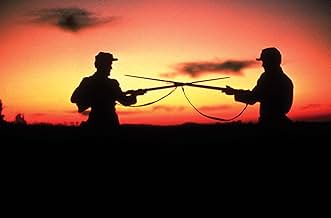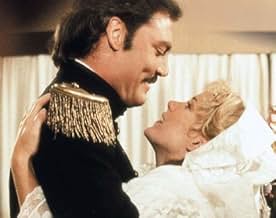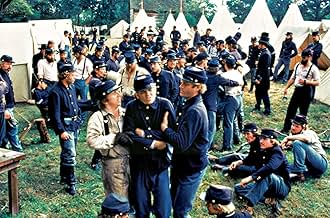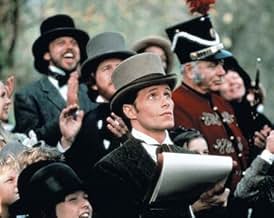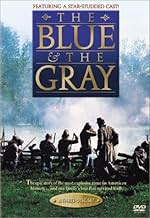America just before and during the Civil War, as seen through the eyes of an artist correspondent.America just before and during the Civil War, as seen through the eyes of an artist correspondent.America just before and during the Civil War, as seen through the eyes of an artist correspondent.
- Nominated for 4 Primetime Emmys
- 2 wins & 4 nominations total
Browse episodes
Featured reviews
This miniseries shows the war primarily through the eyes of a Virginian who wants to witness history but cannot commit to either side of the conflict. His new-found profession of journalism allows him to participate as a neutral observer. He is surrounded by relatives and friends on both sides, and the miniseries shows events through their eyes as well.
The human side of the war is stressed, and it excellently portrays the toll the conflict took on families.
Many of the subplots are taken from Civil War historian Bruce Catton's final work, "Reflections On The Civil War." However, none of the people in the book, including the real John Geyser, appear in the miniseries. Rather, observations made in the book are woven around the main storyline as supplementary material.
Most of the military aspects of the miniseries are laughable and bear little resemblance to reality. Due to the miniseries being done on a miniseries budget we see none of the grand scale evident in "Gettysburg" or "Glory."
Stacy Keach gives a terrific performance as Jonas Steele, the Federal special operations agent. We see from his performance a little of the decentralized, more personalized ways in which intelligence gathering and other non-standard military operations were conducted in the nineteenth century.
The miniseries ran for over six hours on CBS in 1982, but well over an hour was cut for the two-cassette video release. Get the whole treatment if you can.
The human side of the war is stressed, and it excellently portrays the toll the conflict took on families.
Many of the subplots are taken from Civil War historian Bruce Catton's final work, "Reflections On The Civil War." However, none of the people in the book, including the real John Geyser, appear in the miniseries. Rather, observations made in the book are woven around the main storyline as supplementary material.
Most of the military aspects of the miniseries are laughable and bear little resemblance to reality. Due to the miniseries being done on a miniseries budget we see none of the grand scale evident in "Gettysburg" or "Glory."
Stacy Keach gives a terrific performance as Jonas Steele, the Federal special operations agent. We see from his performance a little of the decentralized, more personalized ways in which intelligence gathering and other non-standard military operations were conducted in the nineteenth century.
The miniseries ran for over six hours on CBS in 1982, but well over an hour was cut for the two-cassette video release. Get the whole treatment if you can.
This is such a good movie mainly due to the lack of bias and multiple story lines which keep you hooked throughout the extensive length of the film. I thought that the film was, although of course not the greastest of civil war films, it definitely desearves nothing but good reviews. I saw this movie when i was visiting Utah with family and i had to live in a trailer with my brother and his friend for a few days and all we had was a DVD player and a few movies and some paper and pens. So when we finally decided to watch what seemed like a boring war movie...we never wanted to leave the trailer. Even when invited to go horse-back riding by some neighborhood girls whom my brother had been eyeing. the movie was completely captivating. Everyone should definitely see The Blue and the Gray at LEAST once.
Back in the early Sixties there was a short lived television series called The Americans about two brothers who after their father was killed decided to fight on opposite sides in the Civil War. The whole business about brother against brother was no exaggeration. Right up to the very top with Mary Todd Lincoln having relatives who fought for the Confederacy, families were torn apart. The Blue And The Gray brings that aspect of the Civil War better than any other film made for the big or small screen since The Americans.
The families are the Geysers and the Hales related by the mothers, Diane Baker and Colleen Dewhurst being sisters. The Hales are from Gettysburg, Pennsylvania and the Geysers from what would now be West Virginia in and around Harper's Ferry and that's not even 100 miles distance. But the families are true to the sectional divide.
With the exception of John Geyser played by John Hammond who has made a black friend, a free man played by Paul Winfield who gets lynched for helping runaway slaves. He won't fight for a section that espouses slavery as a cause, but won't enlist in the Northern Armies either. A passing acquaintance played by Stacy Keach who gets himself involved in a lot of the major events of the war and married into the Hale family with Julia Duffy persuades Hammond to become a war correspondent and put his artistic talents to good use. Hammond becomes a pictorial chronicler of the seminal event of his generation.
Without ever losing control of the main story lines, what happens to the various Geyser and Hale family members, The Blue And The Gray captures the sweep and pageantry of the Civil War. Such real characters as Abraham Lincoln played by Gregory Peck and John Brown played by Sterling Hayden in what was his farewell performance do take a life of their own. With Peck we see a public and a private Lincoln which is true to the Lincoln mythology and yet quite a human character.
If I had to single out one performance that was especially touching it would be that of David W. Harper as one of the Hale brothers. The young man was eager to be the first to enlist in his town of Gettysburg, but he never made it to the battle that town became famous for. A not well covered portion of the war was the lack of sanitary facilities in army camps. Young Harper falls victim to dysentery and his performance will move you.
A few years later North and South covered a lot of the same ground that this particular mini-series did and it was as well done as The Blue And The Gray. I would recommend them both highly especially for young audiences to gain a real understanding of what the Civil War meant to the average individual/
The families are the Geysers and the Hales related by the mothers, Diane Baker and Colleen Dewhurst being sisters. The Hales are from Gettysburg, Pennsylvania and the Geysers from what would now be West Virginia in and around Harper's Ferry and that's not even 100 miles distance. But the families are true to the sectional divide.
With the exception of John Geyser played by John Hammond who has made a black friend, a free man played by Paul Winfield who gets lynched for helping runaway slaves. He won't fight for a section that espouses slavery as a cause, but won't enlist in the Northern Armies either. A passing acquaintance played by Stacy Keach who gets himself involved in a lot of the major events of the war and married into the Hale family with Julia Duffy persuades Hammond to become a war correspondent and put his artistic talents to good use. Hammond becomes a pictorial chronicler of the seminal event of his generation.
Without ever losing control of the main story lines, what happens to the various Geyser and Hale family members, The Blue And The Gray captures the sweep and pageantry of the Civil War. Such real characters as Abraham Lincoln played by Gregory Peck and John Brown played by Sterling Hayden in what was his farewell performance do take a life of their own. With Peck we see a public and a private Lincoln which is true to the Lincoln mythology and yet quite a human character.
If I had to single out one performance that was especially touching it would be that of David W. Harper as one of the Hale brothers. The young man was eager to be the first to enlist in his town of Gettysburg, but he never made it to the battle that town became famous for. A not well covered portion of the war was the lack of sanitary facilities in army camps. Young Harper falls victim to dysentery and his performance will move you.
A few years later North and South covered a lot of the same ground that this particular mini-series did and it was as well done as The Blue And The Gray. I would recommend them both highly especially for young audiences to gain a real understanding of what the Civil War meant to the average individual/
As others have mentioned, this is a series of recollections of events which may (or may not) have occurred during the American Civil War. It is related from the point of view of a 'neutral' war correspondent, who's talent is for drawing sketches of what he has seen on various battle fields, from Bull Run to Appomattox Ct. House. There is considerable 'time jumping' from one period of the war, to another, which inhibits continuity to some extent. For me the best part of the mini-series was watching Gregory Peck (as Abraham Lincoln) deliver the Gettysburg address. However, we are thrown into that scene without adequate preamble, so even this is diminished from what it could have been.
I am quite an avid amateur Civil War historian, having read many books and watched many TV series (including the excellent PBS series by Ken Burns, and the complete 3 volume set of books on the Civil War by historian Shelby Foote) on the subject. If you are looking for historical accuracy you will be disappointed. If you, on the other hand, are simply looking for a decent dramatization (ala "Gone With the Wind), you will enjoy this series.
The acting by the cast was, in general, C+, with the exception of a few of the notables (Gregory Peck, for one). As my summary states, this is a dramatic romp, so if you keep that in mind and set your sites correspondingly on the low side, you will not be disappointed.
I am quite an avid amateur Civil War historian, having read many books and watched many TV series (including the excellent PBS series by Ken Burns, and the complete 3 volume set of books on the Civil War by historian Shelby Foote) on the subject. If you are looking for historical accuracy you will be disappointed. If you, on the other hand, are simply looking for a decent dramatization (ala "Gone With the Wind), you will enjoy this series.
The acting by the cast was, in general, C+, with the exception of a few of the notables (Gregory Peck, for one). As my summary states, this is a dramatic romp, so if you keep that in mind and set your sites correspondingly on the low side, you will not be disappointed.
Released in 1982 and directed by Andrew V. McLaglen, "The Blue and the Gray" covers the Civil War era from 1859-1865 focusing on two related families: The Geysers, farmers from Charlottesville, Virginia, and the Hales from Gettysburg, Pennsylvania, who own a newspaper. John Geyser (John Hammond) leaves Virginia to get a job as a sketch artist at the Hale's newspaper in Gettysburg. When war breaks out after the Southern states secede from the Union, John covers the war for Harper's Weekly.
MAIN CAST includes Stacy Keach as a Pinkerton-turned-Union-officer who romances John's cousin (Julia Duffy); Gregory Peck as Lincoln; Kathleen Beller as an aristocrat-turned-nurse; Dan Shor & Michael Horton as John's brother; Rip Torn as General Grant; and Lloyd Bridges & Colleen Dewhurst as Mr. and Mrs. Geyser. These are just the principle characters; there are scores of others (Robert Vaughn, Geraldine Page, Warren Oates, Robert Symonds, etc.).
I prefer "The Blue and the Gray" to the similar "North and South" (Books I & II, 1985-86) because it's more streamlined and less soap opera-y. Director McLaglen had decades of experience by this this time with both TV shows and films, including a few notable Westerns, like "Bandolero!" (1968) and "Chisum" (1970); in fact, his "Shenandoah" (1965) was a Civil War 'Western.'
The first half is great, but the second half flounders a bit and includes some cheesy plot gimmicks, like the mad slasher Confederate officer and John mistaking his babe (the nurse) supposedly making out with the Union stud (Keach). The 'floundering' includes some abrupt shifts, like from the Battle of Vicksburg (July, 1863) to the Battle of the Wilderness (May, 1864), which can likely be explained by cuts from the original mini-series. If you watch the longer version you probably won't encounter this problem.
What I like best about this "miniseries" (i.e. long movie) is that, despite some elements of TV-production cheese (e.g. the two Union & Confederate deserters' almost goofy meeting in the woods), the film takes you back in time to the Civil War era and provides a quality picture of what it was like.
Some of the notable events covered include: The Battle of Bull Run, Army camp life, dysentery in the camps, cowards in battle and the branding thereof, balloon reconnaissance, fraternizing with the enemy after hours, brother vs. brother, the Gettysburg Address, the siege of Vicksburg and the desperation thereof (e.g. the Caves), prisoner-of-war camps (Elmira), Lee's surrender and Lincoln's death. Yes, some key events are off-screen (e.g. the Battle of Gettysburg and Lincoln getting shot), but that's the nature of the beast with a TV-budget and an overview-styled story. Lastly, Keach shines as one of the main protagonists, easily one of his best rolls, and Duffy is a delight.
The film runs 296 minutes (4 minutes shy of 5 hours), with the original 3-part miniseries running 381 minutes. It was shot entirely in Arkansas (Fort Smith, Eureka Springs, Fayetteville, Van Buren & Prairie Grove Battlefield State Park). The script was written by John Leekley & Ian McLellan Hunter based on Bruce Catton's material.
GRADE: B
MAIN CAST includes Stacy Keach as a Pinkerton-turned-Union-officer who romances John's cousin (Julia Duffy); Gregory Peck as Lincoln; Kathleen Beller as an aristocrat-turned-nurse; Dan Shor & Michael Horton as John's brother; Rip Torn as General Grant; and Lloyd Bridges & Colleen Dewhurst as Mr. and Mrs. Geyser. These are just the principle characters; there are scores of others (Robert Vaughn, Geraldine Page, Warren Oates, Robert Symonds, etc.).
I prefer "The Blue and the Gray" to the similar "North and South" (Books I & II, 1985-86) because it's more streamlined and less soap opera-y. Director McLaglen had decades of experience by this this time with both TV shows and films, including a few notable Westerns, like "Bandolero!" (1968) and "Chisum" (1970); in fact, his "Shenandoah" (1965) was a Civil War 'Western.'
The first half is great, but the second half flounders a bit and includes some cheesy plot gimmicks, like the mad slasher Confederate officer and John mistaking his babe (the nurse) supposedly making out with the Union stud (Keach). The 'floundering' includes some abrupt shifts, like from the Battle of Vicksburg (July, 1863) to the Battle of the Wilderness (May, 1864), which can likely be explained by cuts from the original mini-series. If you watch the longer version you probably won't encounter this problem.
What I like best about this "miniseries" (i.e. long movie) is that, despite some elements of TV-production cheese (e.g. the two Union & Confederate deserters' almost goofy meeting in the woods), the film takes you back in time to the Civil War era and provides a quality picture of what it was like.
Some of the notable events covered include: The Battle of Bull Run, Army camp life, dysentery in the camps, cowards in battle and the branding thereof, balloon reconnaissance, fraternizing with the enemy after hours, brother vs. brother, the Gettysburg Address, the siege of Vicksburg and the desperation thereof (e.g. the Caves), prisoner-of-war camps (Elmira), Lee's surrender and Lincoln's death. Yes, some key events are off-screen (e.g. the Battle of Gettysburg and Lincoln getting shot), but that's the nature of the beast with a TV-budget and an overview-styled story. Lastly, Keach shines as one of the main protagonists, easily one of his best rolls, and Duffy is a delight.
The film runs 296 minutes (4 minutes shy of 5 hours), with the original 3-part miniseries running 381 minutes. It was shot entirely in Arkansas (Fort Smith, Eureka Springs, Fayetteville, Van Buren & Prairie Grove Battlefield State Park). The script was written by John Leekley & Ian McLellan Hunter based on Bruce Catton's material.
GRADE: B
Did you know
- TriviaSome filming took place at Prairie Grove Battlefield State Park in Arkansas. The film crew built a false side onto a historic building there, then blew it off for a special effect, assuring the State park officials that no harm would come to the building. The explosion was larger than promised, damaging the historic house's structure.
- GoofsWhen John Brown is hanged for the uprising at Harper's Ferry, the apple trees are in full blossom. John Brown was hanged on 2 December 1859.
- Quotes
Abraham Lincoln: It's well known that the more a man speaks, the less he's understood.
- ConnectionsReferenced in Saturday Night Live: Drew Barrymore/Squeeze (1982)
- SoundtracksRock of Ages
Lyrics by Augustus Montague Toplady (as Augustus M. Toplady)
Music by Thomas Hastings
- How many seasons does The Blue and the Gray have?Powered by Alexa
Details
Contribute to this page
Suggest an edit or add missing content




